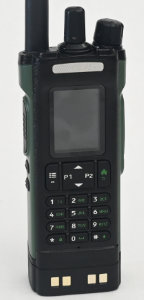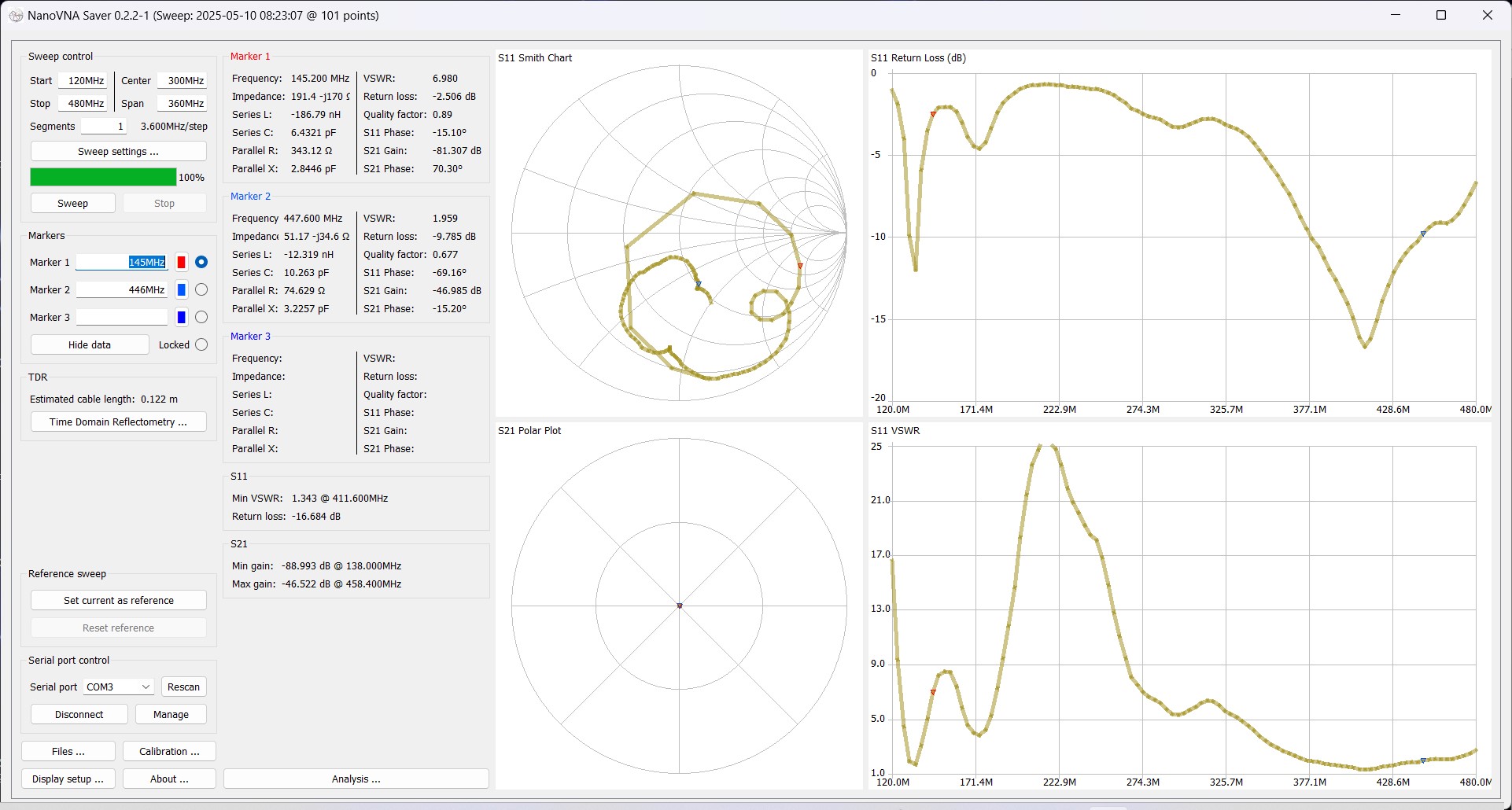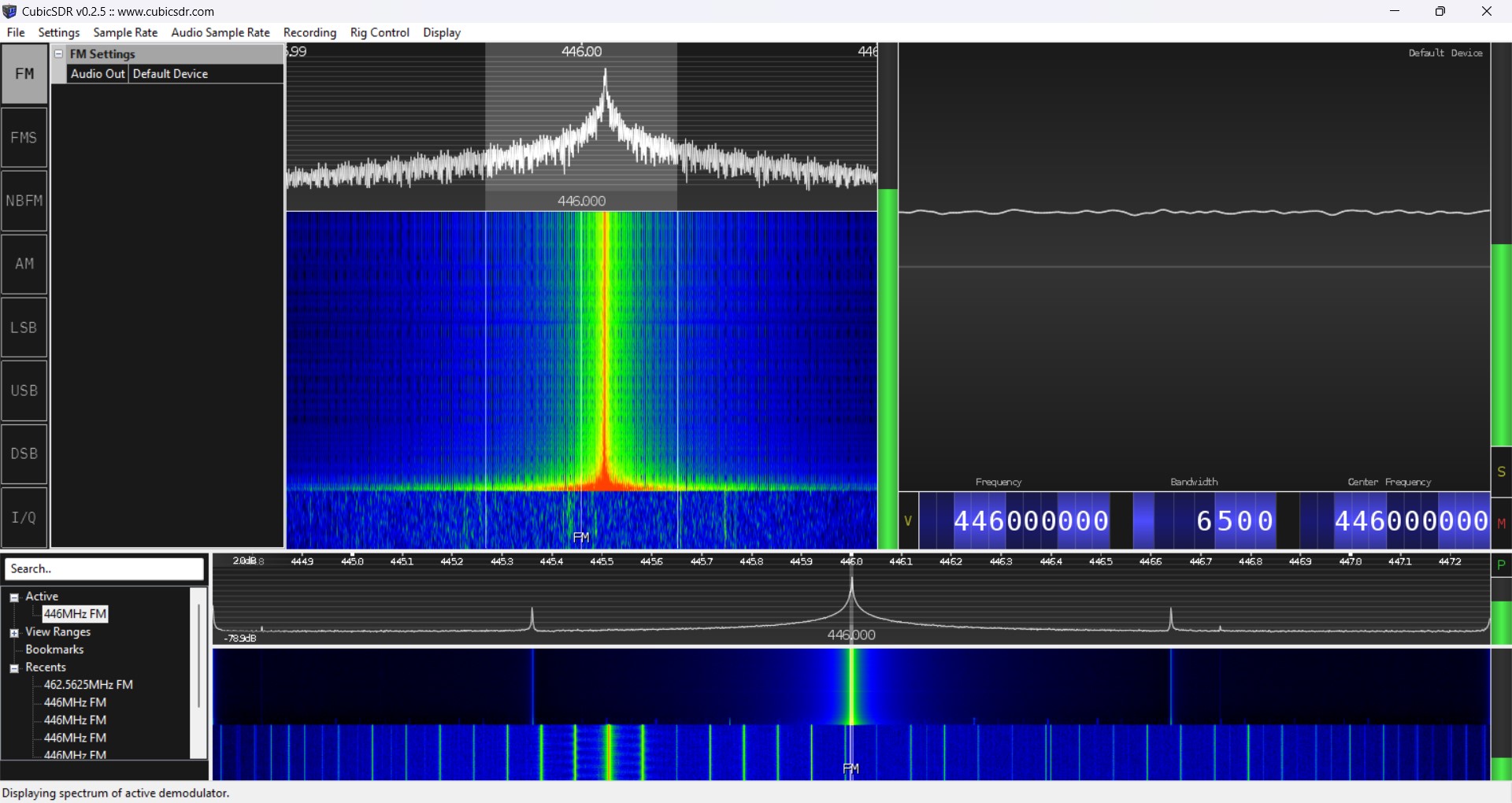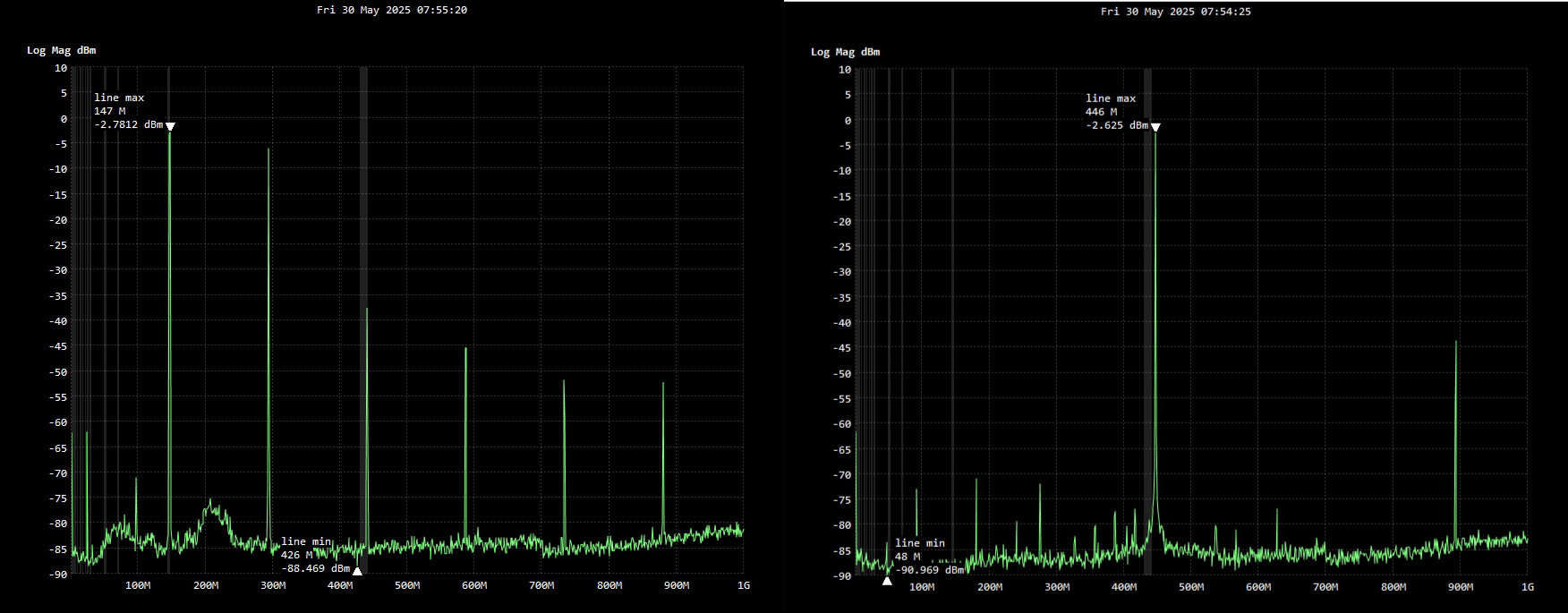The Baofeng UV-32 is one of several radios recently released that are just plain big. The Hamgeek APX-8000, Baofeng UV-25, and the Baofeng AR-152 are all close to the same size. These are definitely not meant to be pocketable radios. The AR -152 was basically an oversized UV-5R, with a really big battery on the bottom. The question is, is this more of the same?
This radio has plenty of odd features on it including charging contacts on the front of the Radio, navigation buttons typically found on DMR radios, built-in GPS, two knobs instead of one, and oh yes, a very large battery. Let’s take a look and see if that makes the Baofeng UV-32 another copy, or something unique.


The Baofeng UV-32 is one of several radios recently released that are just plain big. The Hamgeek APX-8000, Baofeng UV-25, and the Baofeng AR-152 are all close to the same size. These are definitely not meant to be pocketable radios. The AR -152 was basically an oversized UV-5R, with a really big battery on the bottom. The question is, is this more of the same?
This radio has plenty of odd features on it including charging contacts on the front of the Radio, navigation buttons typically found on DMR radios, built-in GPS, two knobs instead of one, and oh yes, a very large battery. Let’s take a look and see if that makes the Baofeng UV-32 another copy, or something unique.
the first thing you notice when you pick up the Baofeng UV-32 is that it’s really big. Not so big that you can’t hold it, in fact it’s actually a little skinnier than I would like. That is probably primarily due to the fact that there’s no belt clip. Even in my large hands the PTT button is a little awkward, and my finger seems to hit it at or just behind the first knuckle instead of on the tip. Considering the PTT button has a raised piece of plastic all the way around it this makes using the radio feel a little weird.
Speaking of belt clip, not only is there not one, there is no place to put one. Unlike the Hamgeek APX-8000, there isn’t even a cradle. Instead, they have included a fabric holster, which I find cumbersome at best. Maybe it’s just me, but I have a hard time getting the radio in and secured, as well as it taking entirely too long to unsecure and remove the radio. If you’re in a situation where you need quick access to a radio such as Skywarn or an event, make sure you attach an external speaker microphone.
The buttons on the front have a nice tactile feel, or plenty big enough, and have nice little guards in between them to keep from accidentally pressing the wrong button. They also have green text next to the white numbers which in certain lighting situations makes the text difficult to read. The side buttons work well however I am not at all a fan of the plastic ring around the PTT button.
Unlike many radios the Baofeng UV-32 has two knobs on the top deck. The right knob is a power and volume knob, as you would expect. It is smooth and has very little slack in the switch. The center knob rotates 360° and has detents to give a nice feel when you’re changing frequencies, or using it to navigate the menus. I wish most radios had this second knob instead of a flashlight that I never use.
The screen is a little odd in that it measures 1.77 in diagonally, which is common for some of the new Baofeng radios, except it appears to be taller and skinnier than others. Other than that difference, it looks and acts much the same. The colors are bright, the contrast is very good, and when you add in the large numbers for the frequency the main display is easy to read. Also, just like many of the other radios using these types of screens, the backlight is set to turn off in 5 seconds, and you cannot read the screen without the backlight on. The good news is you can adjust that time up to 20 seconds right from the radio without having to hook it to a computer.
One good thing about this radio is that since a good portion of the battery is on the bottom, the base is quite wide, and the entire base is flat, so it is extremely stable sitting on your desk. Of course, it’s also very tall, which makes it easier to accidentally hit the antenna and knock it over anyway. Being fair that also happens to virtually any handheld radio with an aftermarket antenna.
I can see where somebody who gets a Baofeng UV-32 might be confused by the menu. The menu is not your typical Baofeng menu, but it is very similar to the 1801 and 1701. The reason for this is that there is a DMR version of the UV-32 and so in the base version they use the same firmware and disable the DMR functions. That also helps since even this base model has GPS built in. In fact, it uses GNSS instead of standard GPS so lock-ons are even faster, and I’ve noticed that it works under more tree cover than some of my GPS only radios.
The Baofeng UV-32 is another one of those radios where the battery literally screws into the radio for no apparent reason. It does not appear to be waterproof, however I have no doubt it is semi-water resistant. As I said in my UV-17R review, I don’t understand why non-waterproof radios have a screw-in battery, it just makes life more difficult. If you need to carry a spare battery, be sure and carry a screwdriver too.
Speaking of the battery in the Baofeng UV-32, you might think this large battery has a huge capacity. You would be wrong. This battery is only rated at 2500mAh which, when compared to its size, seems rather tiny. The difference is that this 2500mAh battery actually provides 2590mAh unlike 2500mAh batteries on radios like the UV-26 which only test out at 1670mAh. So instead of getting a larger rated capacity, you’re actually getting what you pay for. I know, shocker.
— Find out what battery fits the Baofeng UV-32 with our battery finder tool —
I mentioned earlier that the Baofeng UV-32 has a DMR variant, and it does, it’s called the DM32. It is the same chassis, same screen, same accessories, and same menu except it adds DMR capabilities. This makes it the largest ham radio DMR capable unit I have ever seen. Yes, you can get as large or larger commercial units, but nothing built for the ham community that I have seen.
Since this radio uses DMR style firmware, you cannot program it with chirp. I expected that, but it’s still rather annoying. The good news is the CPS software provided by Baofeng is not bad. I had no problem programming the radio using it. It also appears to be the same software they use to program the DM32, just stripped down and simplified.
Another nice feature about programming this radio is that they made an app for it. You can search the App Store for “Radio Frequency Programmer” and the instructions can be found here. This is not a feature that I use very much, but it is kind of neat. I can absolutely see where some people who don’t really use a computer day today will really like this feature. No computer, no cable, just simple software on your phone.
One thing to watch out for when looking at the listings for the Baofeng UV-32 is that some of them talk about APRS support, including text messaging and other APRS features. I can find no mention of APRS in the menus, or in the official Baofeng user manual. There is, however, plenty of mention of APRS capabilities in the DM32 version of the manual.
Performance:
The Baofeng UV-32 puts out 5w on 2m and 3w on 70cm which is a little above average for Baofeng radios. This begins to look even a little better when you realize the antenna that comes with this radio is pretty poor, even compared to most other Baofeng radios. With only about -12 at 2m and -17 at 70cm of return loss coupled with an SWR of about 2 at 2m and 1.1 at 70CM, and you have an antenna that should probably be replaced fairly quickly if you want to get any kind of distance out of it.
The signal output on the spectrum analysis has a fairly concentrated central area, which is good, but spreads out too much of its power on the sides. The good news here is that it is a little more consistent than most Baofeng radios.
Unfortunately, the Baofeng UV-32 shares another similarity with some of the newer radios in its class, a ton of spurious emissions. With five harmonic spikes above the -60 FCC recommendation, and one that is only 3dB below the main transmission frequency, you are looking at almost 50% of your transmitted power being wasted. Of course this also builds up extra RF and heat in the electronics of your radio, shortening its life, as well as wasting battery power.
Images:
Radio Specifics:
| Screen readability | Very Good | |
| In-hand feel | Good | |
| Included antenna | Terrible | |
| Construction quality | Good | |
| Belt clip | Doesn’t exist | |
| Programmability | Very Good | |
| Transmit audio | CLICK TO LISTEN | |
| Frequency accuracy | 145.000 @ 145.000 | |
| Maximum power output 2m/70cm | 5 watts / 3 watts | |
| Actual weight | 390g | |
| Battery advertised mAh | 2500mAh | |
| Battery tested mAh | 2590mAh | |
| Receiver sensitivity | 134dBm / 132dBm | |
| Screen brightness | 22.5lux | |
| Max audio level | 90.1db | |
| Radio manual | CLICK TO DOWNLOAD | |
| Programming software | CLICK TO DOWNLOAD | |
| Performance score | D | |
| Value score | C | |
| Ergonomics score | C |
Test Images:
If you are interested, click here for an article on how I test radios.
FEATURES:
- Tri-band 2m/1.25m/70cm TX/RX
- Air band receive
- FM radio
- NOAA receive and alerts
- 1000 channels
- Power output 10w
- GPS (GNSS)
- Smartphone app for programming (ios/android)
- One-key frequency copy
- Bluetooth
| PROS: | CONS: |
|
|
The Baofeng UV-32, like a lot of radios today, come in a wide variety of kits with different accessories. Add to that all the kits and accessories for the DM32 DMR variant, and you have a whole slew of choices, not the least of which is colors (including transparent!). I kind of like the olive green that I got, and I also like the looks of the khaki. It’s nice to see some base earth tones Instead of the typical wild colors you see on other radios.
You can also find kits that come with drop-in chargers which I prefer for daily use as compared to USB-C which I find better for travel and taking the radio to the office to listen in during the day.
Conclusions
Even though this large type of radio is not really something I’m into, I had high hopes for a radio sharing firmware with a DMR version, having GNSS, and having a large battery for extended use. Unfortunately the Baofeng UV-32 falls short. Would I recommend the radio? No. I don’t like the holster, the lack of a belt clip, the plastic ring around the PTT button, the terrible antenna, for the ridiculous amount of spurious emissions robbing power and shortening the life of the electronics.
I’m sorry but nice colors, including transparent, and a battery that actually tests above its rating, are not enough to even start getting past its shortcomings. It seems like lately all the radios I reviewed I would not recommend. I really hope that this is not a new trend.
Here are some reviews of the radio!
No example to input VHF offset
I had to search the Web to find the correct way to input a .600 MHz Offset. it was not a standard way most HTs work. There was only an example for UHF 5 MHz offset in the book. Also the font in the HTs Manual was super small. It was maybe 2 or 3 points.















Do you recommend the Baofeng DMR 32?
I think there are better radios for the money. The Radtel RT-40 is nice for the price, as are the TYT offerings. It really depends on what exact features you want and your price range.